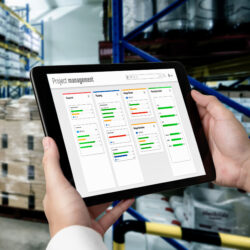The Prediction: By 2026 more than 50% of supply chain organizations will use machine learning

Technologies related to control towers, visibility and machine learning are in the spotlight when it comes to supply chain planning. Supply Chain Media asked a number of international supply chain directors for their reactions to some well-known analyst firms’ predictions about this topic.
The Prediction: According to Gartner, by 2026, more than 50% of supply chain organizations will use machine learning (ML) to augment decision-making capability.
Sami Naffakh, Chief Supply Officer, Member of the Group Executive Committee at Reckitt:
“I actually think it is going to go faster than that. I cannot think of any recent system deployment that did not include some level of ML/AI to support data analysis and decision-making.”
Vineet Khanna, Senior Vice President, Global Head of Supply Chain at Nestlé:
 “Most supply chain organizations have started making use of machine learning in areas like demand sensing and parts of control towers. The challenge is to move from anecdotal to systemic use in the E2E supply chain to improve efficiency as well as agility, and this would be possible for fewer supply chain organizations considering the challenges outlined in the answer to the first question.”
“Most supply chain organizations have started making use of machine learning in areas like demand sensing and parts of control towers. The challenge is to move from anecdotal to systemic use in the E2E supply chain to improve efficiency as well as agility, and this would be possible for fewer supply chain organizations considering the challenges outlined in the answer to the first question.”
Thomas Panzer, SVP – Head Supply Chain Management at Bayer AG:
“I expect a huge increase of machine learning features in our planning and execution systems over the coming years and would therefore subscribe to this statement.”
Olav Gribnau, Supply Chain Director Northern Europe at Hero Group:
 “I firmly believe that machine learning can improve decision-making, but then the current leadership of the more traditional companies (and their IT departments) must take more interest in this kind of technology. I sincerely hope this will rise above 50%, but I’m afraid the technically oriented ‘new’ companies will have a big lead on the classic companies here… I see a great challenge.”
“I firmly believe that machine learning can improve decision-making, but then the current leadership of the more traditional companies (and their IT departments) must take more interest in this kind of technology. I sincerely hope this will rise above 50%, but I’m afraid the technically oriented ‘new’ companies will have a big lead on the classic companies here… I see a great challenge.”
Freek van Iersel, Supply Chain Director Electronics EMEA at Signify:
“I think 2026 is too far away. I expect that certainly the medium-to-large supply chain organizations will use machine learning much earlier. In our case, we already use it in demand planning, and I expect that in a relatively short time this method could also be available for somewhat smaller supply chain organizations.”










